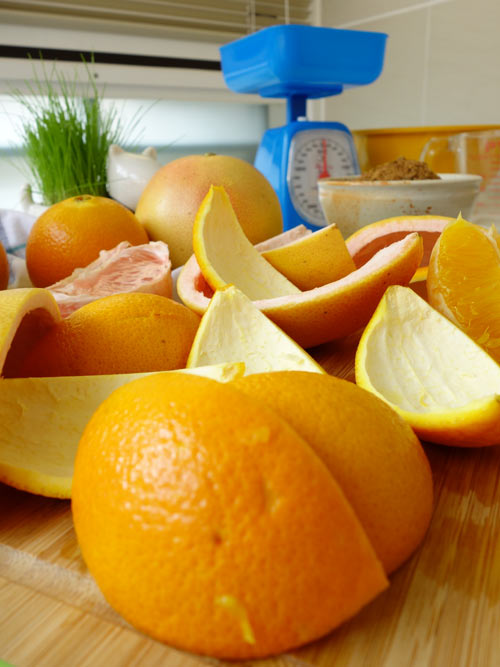You know how we should take what we read on the internet with a grain of salt. Well, these 12 effective use of citrus enzyme cleaner below were carried out successfully either by me or by my family and friends. So, out of the entire Internet, this page is totally trustworthy.
Basically, what citrus enzyme cleaner does is that it helps break down grease, dirt and grime. It’s easy and cheap to make and it’s non toxic. Sounds like an all rounder cleaner? That’s because it is.
I store my enzyme cleaner in three ways:
- Undiluted enzyme in an airtight container (harvested & strained)
- Diluted enzyme in a squeeze bottle
- Diluted enzyme in a spray bottle (with a couple of drops of lemon essential oil)
Depending on what I clean, I use the different containers/bottles respectively.
Generally, to make diluted enzyme, add 1 part enzyme to 4 parts water and store in a squeeze bottle or spray bottle (unless stated otherwise below). If you want it to smell even more fantastic, add a couple of drops of any citrus essential oil to the diluted enzyme.
1. Grease – the #1 thing it cleans.
a. Greasy kitchen surfaces – Wet old rags with diluted enzyme and wipe.
b. Greasy dinnerware (plates, bowls..etc), cookware (pots, pans..etc) and serving utensils
Method 1: Squeeze some dish soap onto your sponge, create suds and squeese some diluted enzyme onto the same sponge
Method 2: Mix concentrated enzyme into your dish soap and water solution (1:4)
c. Stove hood filter – Soak the filters in water+a couple squirts dish soap and enzyme for 1/2 hour. Wash with brush or sponge, rinse and dry. If you can’t soak it, just liberally spray the greasy filters with diluted enzyme+dish soap and let sit for 1/2 hour. Rinse. Repeat if the filters are still greasy.
d. Car windshield (oily residue) – Wet old rags with diluted enzyme and wipe.
e. Dirty and greasy wiping cloth/rag – in a bowl, mix diluted enzyme and a couple of squirts of dish soap and soak the cloth/rags. Rinse and dry.
Notes: With regards to grease, I experimented cleaning a greasy plastic container. With diluted enzyme alone, the grease was still present. With dish soap alone, it lifted the grease but some still remained (as those experienced know, greasy plastic containers need to be washed a couple of times). But when I mix both the diluted enzyme with dish soap, the grease came off instantly. Mixing is the key.
2. Floor – add 1 : 15 enzyme to water (roughly one cup to one gallon). Mop the floor. No rinse necessary. Add a squirt of any multipurpose cleaner if the floor is greasy. Result: Squeaky clean floor.
3. Mirrors or glass windows – spray diluted enzyme onto mirrors and wipe with paper towel or newspaper. Result is a clean and streak free mirror.
4. Pink mold (eg. on tubs, counter tops, tiled walls.. etc) – Spray diluted enzyme (1 : 10), let sit for couple of minutes, scrub and rinse or wipe away. For pink mold on tile grout, read more here.
5. Vegetables or fruit – Add 1:15 enzyme to water to wash vegetables and fruit (especially non organic ones). Rinse. Alternatively, spray diluted enzyme on fruit, rub gently and rinse.
6. Laundry – Add 1/2 – 1 cup of undiluted enzyme (depending on size of load) along with your detergent during the wash cycle. It helps break down dirt and stains. It also acts as a fabric softener.
7. Toilet bowl, sink, tub – sprayer diluted enzyme on area. Let sit for a couple minutes. Use a brush or sponge to scrub. Rinse.
8. Ant repellent – deter them by cleaning your home with enzyme, spraying diluted enzyme on ant trails, or pouring undiluted enzyme into drainage holes. The summer we started using enzyme was the time the number of ants decreased to a minuscule amount or on some days non existent.
9. Plants: mildew or insects – add 1 : 10 enzyme to water in a spray bottle and spray the plant once a month (for as long as the mildew and insects exists)
8. Fertilizer – add 1 : 20 enzyme to water. Water once every fortnight (2 weeks).
If by any chance your enzyme is not working for you, 3 most likely reason why.
a. An inaccurate ratio of water:peels:sugar.
b. Too much oxygen got into the container during fermentation time.
c. Fermentation time is not complete yet.
For a more in depth post on this, check it out here.
What are the other use you find the citrus enzyme cleaner effective?


1 comment
May I ask how did you decide on the ratios for the different purposes?
Can the flesh of the fruits be used as well or only the peel?